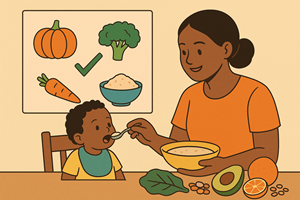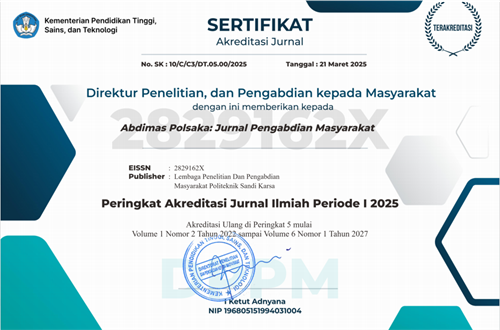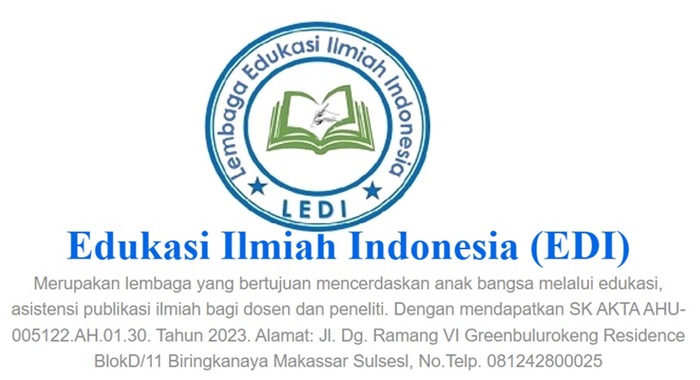Nutritious food education and the practice of providing complementary foods are appropriate in efforts to prevent stunting
DOI:
https://doi.org/10.35816/abdimaspolsaka.v4i2.94Keywords:
Nutrition Education, MP-ASI, Nutritious Food, StuntingAbstract
Stunting is a chronic nutritional problem still a public health challenge in Indonesia. One of the factors contributing to the high prevalence of stunting is the lack of knowledge of parents, especially mothers, about balanced nutritional intake and proper practices of feeding Complementary Breast Milk (MP-ASI). This community service activity aims to improve the knowledge and skills of mothers under five related to the importance of nutritious food and the practice of giving MP-ASI in accordance with the guidelines of WHO and the Ministry of Health of the Republic of Indonesia. The methods used are education through interactive counseling, demonstrations of making local food-based MP-ASI, and question and answer sessions. The target of the activity was 40 mothers with children aged 6-24 months in the Posyandu in the assisted area. The evaluation results showed an increase in participants' knowledge by 65% after participating in educational activities. In addition, 80% of participants stated that they were motivated to implement MP-ASI feeding practices that are in accordance with the principles of balanced nutrition. This activity also encourages the use of affordable and nutritious local food resources. With the increase in mothers' knowledge and skills in compiling and delivering MP-ASI, it is hoped that the risk of stunting in early childhood can be minimized. This service activity proves that education-based interventions and direct practices can effectively support programs to accelerate stunting reduction at the community level. The recommendation for the future is to expand the scope of similar activities with cross-sectoral collaboration, especially among health workers and posyandu cadres.
Downloads
References
S. Suprapto, “Pengaruh Edukasi Media Kartun Terhadap Peningkatan Pengetahuan Ibu dan Status Gizi Anak,” J. Heal., vol. 9, no. 2, pp. 81–87, Jul. 2022, doi: https://doi.org/10.30590/joh.v9n2.500.
A. S. Asmi, I. A. Tyarini, M. K. F. Saputra, J. A. Putra, and H. K. Son, “Video media is more effective to improve balanced nutrition knowledge,” J. Ilm. Kesehat. Sandi Husada, vol. 13, no. 2, pp. 242–249, Dec. 2024, doi: https://doi.org/10.35816/jiskh.v13i2.1210.
D. Arda, N. N. L. N. Lalla, and S. Suprapto, “Analysis of the Effect of Malnutrition Status on Toddlers,” J. Ilm. Kesehat. Sandi Husada, vol. 12, no. 1, pp. 111–116, Jun. 2023, doi: https://doi.org/10.35816/jiskh.v12i1.910.
S. Suprapto, T. C. Mulat, and H. Hartaty, “Edukasi Gizi Seimbang Menggunakan Media Video terhadap Pengetahuan dan Sikap Mahasiswa di Masa Pandemi Covid-19,” J. Keperawatan Prof., vol. 3, no. 1, pp. 96–102, May 2022, doi: https://doi.org/10.36590/kepo.v3i1.303.
R. Millati, A. Setyawati, I. Aris Tyarini, and I. Daiyah, “Capacity building of posyandu cadres through education and training in stunting prevention,” Abdimas Polsaka, vol. 4, no. 1, pp. 08–14, Mar. 2025, doi: https://doi.org/10.35816/abdimaspolsaka.v4i1.84.
E. Puji Ati et al., “Building anti-stunting youth awareness,” Abdimas Polsaka, vol. 4, no. 1, pp. 37–42, Mar. 2025, doi: https://doi.org/10.35816/abdimaspolsaka.v4i1.88.
R. Ayu Rahmadani, A. Setiawati, I. Aris, A. Lontaan, and P. Prasetyowati, “Effectiveness of nutrition education on stunting prevention behavior in mothers under five,” J. Edukasi Ilm. Kesehat., vol. 3, no. 1, pp. 01–08, Mar. 2025, doi: https://doi.org/10.61099/junedik.v3i1.68.
H. Hatijar, A. Setiawati, L. Situmeang, I. Aris Tyarini, S. Zakiyyah Putri, and L. Yunita, “Balanced nutrition education as an effort to prevent stunting in toddlers,” J. Pengabdi. Masy. Edukasi Indones., vol. 2, no. 2, pp. 39–46, May 2025, doi: https://doi.org/10.61099/jpmei.v2i2.74.
I. Aris Tyarini, M. Kurni Menga, and A. Setiawati, “The effect of nutritional status of pregnant women on the incidence of stunting in early childhood: determinants of growth and development,” J. Edukasi Ilm. Kesehat., vol. 3, no. 1, pp. 24–31, Mar. 2025, doi: https://doi.org/10.61099/junedik.v3i1.71.
S. Suprapto and M. Ihsan Kamaruddin, “Integration of digital technology by health analysts in health information systems: Systematic Review,” J. Interdiscip. Heal., vol. 1, no. 1, pp. 34–43, May 2025, doi: https://doi.org/10.61099/jih.v1i1.105.
J. Hales, J. Kemper, S. K. White, and E. Veer, “Reflections on food policy in the context of healthy and sustainable diets,” Food Policy, vol. 128, p. 102708, Oct. 2024, doi: https://doi.org/10.1016/j.foodpol.2024.102708.
T. Sundjaya et al., “Gut Microbiome Changes among Undernutrition and Stunting Infants and Children under 2 Years: A Scoping Review,” Open Public Health J., vol. 17, no. 1, Sep. 2024, doi: https://doi.org/10.2174/0118749445319116240729045056.
K. P. Yang, T. M. Bray, A. Chaudhuri, S. B. Syam, and S. K. Khanna, “Barriers to child nutrition in Bengaluru slums: Caregiver insights from the SCOPE strategy,” Eval. Program Plann., vol. 111, p. 102612, Aug. 2025, doi: https://doi.org/10.1016/j.evalprogplan.2025.102612.
B. Even et al., “From Streets to Tables: Bottom–Up Co-creation Case Studies for Healthier Food Environments in Vietnam and Nigeria,” Curr. Dev. Nutr., vol. 8, no. 8, p. 104395, Aug. 2024, doi: https://doi.org/10.1016/j.cdnut.2024.104395.
H. Jalil, M.-C. Chong, M. Y. Jalaludin, L. P. Wong, and N. T. T. Hmwe, “Knowledge, attitude, and practice among mothers toward breastfeeding and complementary feeding in community health setting, Malaysia,” Heliyon, vol. 10, no. 21, p. e39746, Nov. 2024, doi: https://doi.org/10.1016/j.heliyon.2024.e39746.
B. A. Paramashanti et al., “Caregiver perceptions of complementary feeding in rural and urban Indonesia: A qualitative comparative study,” Midwifery, vol. 138, p. 104146, Nov. 2024, doi: https://doi.org/10.1016/j.midw.2024.104146.
N. Kaur et al., “Combat the growing prevalence of anaemia through underutilised iron-rich plant-based foods,” J. Agric. Food Res., vol. 19, p. 101688, Mar. 2025, doi: https://doi.org/10.1016/j.jafr.2025.101688.
S. B. Soofi et al., “Specialized nutritious foods and behavior change communication interventions during the first 1000 d of life to prevent stunting: a quasi-experimental study in Afghanistan,” Am. J. Clin. Nutr., vol. 120, no. 3, pp. 560–569, Sep. 2024, doi: https://doi.org/10.1016/j.ajcnut.2024.07.007.
S. J. W. Astuti, S. Suindyah Dwiningwarni, and S. Atmojo, “Modeling environmental interactions and collaborative interventions for childhood stunting: A case from Indonesia,” Dialogues Heal., vol. 6, p. 100206, Jun. 2025, doi: https://doi.org/10.1016/j.dialog.2025.100206.
D. D. Headey, H. Alderman, J. Hoddinott, and S. Narayanan, “The glass of milk half-empty? Dairy development and nutrition in low and middle income countries,” Food Policy, vol. 122, p. 102585, Jan. 2024, doi: https://doi.org/10.1016/j.foodpol.2023.102585.

Additional Files
Published
How to Cite
Issue
Section
License
Copyright (c) 2025 Risna Ayu Rahmadani, Prasetyowati Prasetyowati, Indrawati Aris Tyarini, Rasi Rahagia, Matilda Martha Paseno

This work is licensed under a Creative Commons Attribution 4.0 International License.
Most read articles by the same author(s)
- Rasi Rahagia, Nour Sriyanah, Indrawati Aris Tyarini, Anita Lontaan, Muh Yunus, Upaya Pencegahan Stunting Berbasis Edukasi dan Sosialisasi , Abdimas Polsaka: Vol. 2 No. 1 (2023): Abdimas Polsaka: Jurnal Pengabdian Masyarakat
- Risna Ayu Rahmadani, Andi Asliana Sainal, Suprapto Suprapto, Community Empowerment to Increase Knowledge About Tuberculosis , Abdimas Polsaka: Vol. 2 No. 2 (2023): Abdimas Polsaka: Jurnal Pengabdian Masyarakat
- Indrawati Aris Tyarini, Ari Setiawati, Viyan Septiyana Achmad, Astuti Astuti, Improving Healthy Behavior in Preventing Stunting through Digital Media , Abdimas Polsaka: Vol. 2 No. 2 (2023): Abdimas Polsaka: Jurnal Pengabdian Masyarakat
- Wa Ode Novi Angreni, Rasi Rahagia, Ari Setyawati, Muh. Ihsan Kamaruddin, Suprapto Suprapto, Community participation in clean and healthy living as an effort to improve the quality of health , Abdimas Polsaka: Vol. 3 No. 1 (2024): Abdimas Polsaka: Jurnal Pengabdian Masyarakat
- Ari Setyawati, Glendy Ariando Salomon, Nordianiwati Nordianiwati, Risna Ayu Rahmadani, Herlina Herlina, Meningkatkan Kapasitas Kader Posyandu dalam Upaya Pencegahan dan Penanganan Stunting , Abdimas Polsaka: Vol. 2 No. 1 (2023): Abdimas Polsaka: Jurnal Pengabdian Masyarakat
- Nordianiwati Nordianiwati, Nur Gilang Fitriana, Lamria Situmeang, Indrawati Aris Tyarini, Ari Setyawati, Education on the role of family in stunting prevention in toddlers , Abdimas Polsaka: Vol. 3 No. 1 (2024): Abdimas Polsaka: Jurnal Pengabdian Masyarakat
- Lamria Situmeang, Muh Yunus, Mery Kana, Moh Malikul Mulki, Rasi Rahagia, Early education on diabetes mellitus for the community , Abdimas Polsaka: Vol. 3 No. 2 (2024): Abdimas Polsaka: Jurnal Pengabdian Masyarakat
- Sulistyani Prabu Aji, Sumarmi Sumarmi, Rida' Millati, Yoga Tri Wijayanti, Indrawati Aris Tyarini, Increasing Community Nutrition Awareness through Balanced Nutrition Education Program , Abdimas Polsaka: Vol. 3 No. 1 (2024): Abdimas Polsaka: Jurnal Pengabdian Masyarakat
- Anita Lontaan, Glendy Ariando Salomon, Risna Ayu Rahmadani , Anggeraeni Anggeraeni, Viyan Septiyana Achmad, Cough Education is Effective for Parental Independence in Overcoming Children's Cough , Abdimas Polsaka: Vol. 2 No. 2 (2023): Abdimas Polsaka: Jurnal Pengabdian Masyarakat
- Lamria Situmeang, Rida Millati, Tridamayanty Syamsul, Indrawati Aris Tyarini, Ari Setiawati, Yefta Primasari, Improving parenting and healthy nutrition for stunted toddler mothers through community service programs , Abdimas Polsaka: Vol. 3 No. 2 (2024): Abdimas Polsaka: Jurnal Pengabdian Masyarakat




















